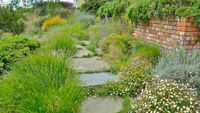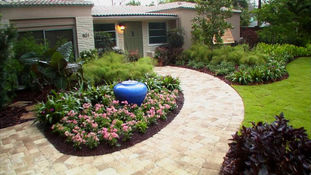

Why are alternative lawns beneficial?
Traditional grass lawns may seem harmless, but in fact, they’re one of the worst options for filling a yard in terms of their environmental impact. Not only are they expensive, grass lawns also contribute to global warming, droughts, and the endangerment of local plant and animal species.
Alternative lawns, on the other hand, are cheaper to maintain, more eco-friendly, and provide a welcoming environment for native species. And the best part? There's a type of alternative lawn for every type of homeowner.
How do grass lawns harm the environment?
Grass lawns typically...
...Which in turn...
are made of a non-native
species of grass
pushes out native grasses, clovers, and flowers, often putting those species at risk of endangerment
are a monoculture (only
contain one species)
provides virtually no habitat for local animal species, which are often seen as “pests” by homeowners
require constant watering
to maintain
uses a valuable resource, fresh water, for a purely cosmetic purpose, which contributes to droughts in some areas
require the use of chemical
pesticides to maintain
can harm not only “weed” species but local wildlife, pets, and even neighbors who are unaware of their dangers
require a gas-powered
mower to maintain
creates a significant amount of pollution, even more than a gas-powered car
And of course, grass lawns can be expensive to keep and maintain, as most homeowners are well aware of. Between mowing, watering, fertilizing, and weeding, the average American homeowner spends over $90 (and almost 60 hours) per year just maintaining their already existing lawn.
Alternative lawns come in a variety of styles and can be made up of native species, provide a better habitat for local wildlife, and/or require much less water use and little to no mowing or pesticide use. They're a win-win for homeowners and the environment.

Which type of lawn is best for me?
There's no one singular look for an alternative lawn. “Alternative lawn” is a term that covers a wide range of landscaping choices — if it isn’t a traditional grass lawn, it’s an alternative lawn. In fact, most neighborhoods have some lawns that use landscaping features seen in alternative lawns, like gardens or xeriscaping.
Different types of alternative lawns can be sorted into a few loose categories. Each type of has its own pros and cons and meets the different needs of different homeowners — because every yard and home is unique.
No-Mow Lawns
No-mow lawns, sometimes called meadow lawns, are the easiest type of alternative lawn to transition to. The name says it all: just stop mowing and let local plant life take over. There’s still some pruning that needs to be done for an environmentally friendly yard, though: invasive species (which vary from region to region) need to be weeded out to keep the ecosystem healthy. But a bit of pruning involves much less effort (and much less pollution) than mowing and watering your lawn regularly.
No-mow lawns are great for homeowners who don’t have the time or money to make large-scale changes to their yard but still want to cut down on cost and provide a habitat for local wildlife. With the addition of native wildflowers, they can also be a beautiful seasonal sight. But homeowners’ associations might not be too friendly about them, and not all climates are suited for wild grasses.
Sarah Baker, an Ohio homeowner, talks about her no-mow journey in an article in the Chicago Tribune here.
Tapestry Lawns
Tapestry lawns keep the same height as a traditional mowed grass lawn without the lawn mower. These lawns use a variety of naturally low-lying plants, including mosses, clovers, herbs, flowers, and different types of grasses to replace a yard’s grass with a tapestry of colorful flora. These lawns are customizable with species local to your area, and mowing is optional (though some styles recommend moving a few times a year).
Tapestry lawns are great for homeowners who want an outdoor space that’s usable but not heavily landscaped. It’s great for homes with kids or outdoor pets. It does require removal of all the old turf, though, so it’s a little more time and money intensive than a no-mow lawn. You’ll also need to find a list of plants that are native to your area for you to use.
Grass-Free Lawns, a UK-based project, has great information about tapestry lawns on their site here.
Landscaped Lawns
Landscaped yards are perhaps the most flexible type of alternative lawn. These yards eliminate the need for grass or a grass replacement altogether, instead opting for a more decorative approach. These yards can include a variety of plants both big and small, outdoor living space with room for chairs, a grill, or fire pits, and flower, herb, or vegetable gardens. What you include is up to you and your needs.
Landscaping however, is the most expensive and time-intensive process for updating your lawn. You’ll either need to hire a landscaper or put in your own hours of effort to give your yard a total overhaul. But the end result is worth it, giving you a yard that extends your living space into nature. Landscaped lawns are especially good for dry climates as they lend themselves to water-friendly landscaping techniques known as xeriscaping.
Eartheasy, a sustainable living focused business, has a great source of information about xeriscaping here.
Garden Lawns
For those with a green thumb, a great way to make use of your property is to convert it to gardens. These can be decorative gardens with flowers and ornamental plants, or edible gardens that grow fruits, vegetables, or herbs. Not only are garden lawns environmentally friendly, but they can also save you money in the long term by supplementing your grocery trips with fresh produce.
Garden lawns do require a commitment, especially if you're planning on creating an edible garden, but there are low-maintenance plant options available to fill your garden beds. Make sure you know how much sunlight each part of your yard gets so you can pick plants that will thrive best.
Food is Free, a movement focused on helping homeowners grow their own food, has great information on how to start an at-home garden here.
Hybrid Lawns
Hybrid lawns are not one style of lawn, but rather a combination of multiple types. Maybe you want a tapestry lawn, but you also want a landscaped sitting area. Maybe you'd like to let your yard grow out into a meadow, but you also want to include a garden section. Or maybe you're not ready to go fully grass-less and only want to change part of your yard. Those would all be called hybrid lawns.
Replacing the grass in even a small part of your yard can have a big impact environmentally. For a lot of homeowners, it may be easiest to change a small section before fully committing. In fact, chances are you already have a grass-free section of your lawn — patios, flower beds, moss lawns all are grass-free yard options that are common in neighborhoods across America.
Better Homes & Gardens has a great article on how to plan out your lawn here, and Lowe's also has a similar but equally helpful article here.

How do I switch to an alternative lawn?
So you're considering switching to an alternative lawn. That's great!
Creating an alternative lawn is different for everyone. In some cases, it's as easy as crossing mowing off of your to-do list. In other cases, you'll need to look into hiring a landscaper or getting equipment to get hands-on with your yard.
No matter what type of alternative lawn you're planning to switch to, though, there's a few key steps to consider before diving in.
1
Make a plan
The first step to creating an alternative lawn is planning out exactly what you want your alternative lawn to look like.
For some options, this can be as simple as noting that you’ll need to replace all your grass with a new plant mix, or that once you stop mowing your grass you’ll need a pathway to get to your back shed. If you’re going for a more decorated or divided yard, bringing in a landscaping expert might be helpful to figure out the optimal layout.
For most plans, it’s a good idea to get measurements of your yard with structures included so you have a clear idea of how much space you’re going to be converting.
Get approval
2
Before making any major changes to your yard, make sure to check with the people you share your house with, as well as your landlord, homeowners' association, and city or county laws to make sure your plan is okay.
Homeowners' associations often have very restricting limitations that don't allow for most types of alternative lawns. If your plans don’t work under your current HOA restrictions, you’ll need to contact your HOA and discuss loosening or removing the restrictions. For help with this, check out the HOA Help page.
3
Choose materials
Once your plan is approved, you’ll need to pick which plant species and decorative objects you’ll actually use. Make sure the plant species you've chosen are local to your area and will grow to the right size.
For finding local plant species, check out the Organizations page for resources dedicated to helping spread native plants.
If you’re including walkways, garden beds, planters, irrigation, water collection, or any other installations, decide what materials will work best for your needs.
Get to work
4
Once your plan is approved and you have the materials selected, it's time to get hands-on with your lawn. For a no-mow lawn, all you'll need to do it weed out invasive species. For a more structured lawn or a bigger lawn overhaul, you'll need to remove the pre-existing grass to make room for your new alternative lawn.
If you’re changing your yard in such a way that a lot of work needs to be done, consider hiring a landscaping company. Although this can be expensive depending on your plans, it makes the conversion process a lot easier on your part. One option is to hire a professional for the biggest or most difficult parts of the process and DIY the rest.
5
Maintain your yard
Although you'll no longer need to mow your lawn every week, alternative lawns still need a little bit of upkeep every now and then.
Invasive species should be weeded out to keep your lawn and the local ecosystem healthy. It’s a good idea to learn to identify these when you first make the switch to an alternative lawn so you can keep your eye out for them, especially if you’re going no-mow with a grass lawn.
















































